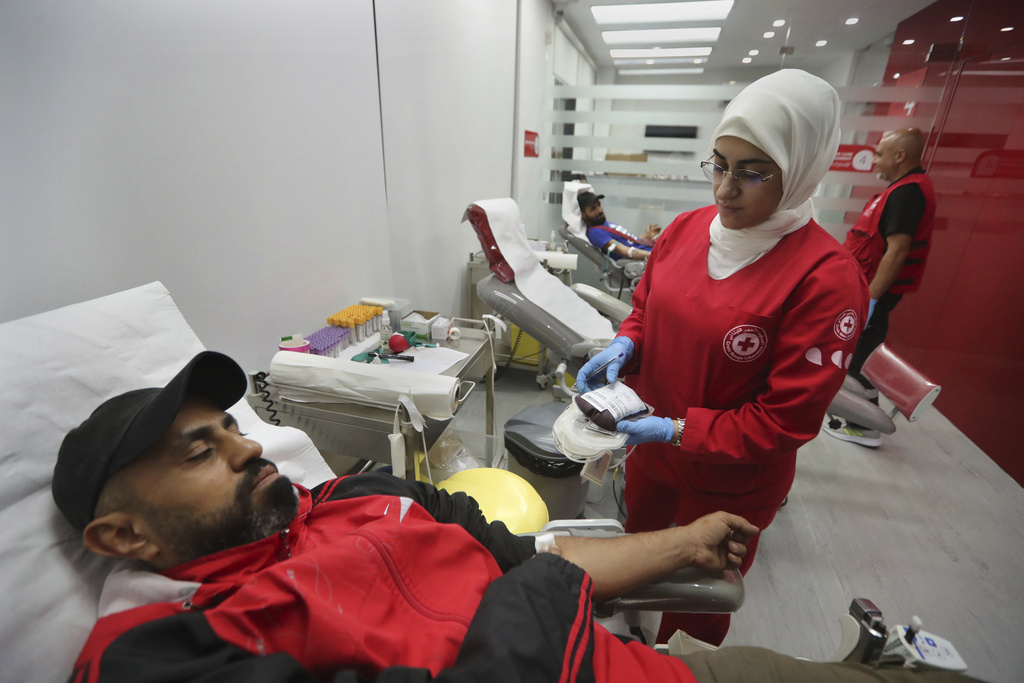Wave of Explosions Hits Hezbollah in Lebanon, Fears of Escalation \ Newslooks \ Washington DC \ Mary Sidiqi \ Evening Edition \ Lebanon was rocked by two waves of explosions this week, with pagers and electronic devices detonating across the country, killing at least 32 people and injuring hundreds. The attacks, widely attributed to Israel, targeted Hezbollah members but also caused significant civilian casualties. The attacks have raised concerns about potential escalation between Israel and Hezbollah, while deepening fears over compromised electronic devices used by the militant group.
Quick Looks
- Coordinated attacks: Two waves of explosions hit Lebanon, targeting Hezbollah members’ electronic devices on Tuesday and Wednesday, killing at least 32 people and wounding hundreds.
- Device sabotage: Pagers, walkie-talkies, and solar energy systems were rigged to detonate remotely, with speculation that the attacks were carried out by Israel.
- High civilian casualties: Explosions occurred in homes, cars, and public spaces, causing numerous civilian injuries and fatalities.
- Sophisticated operation: Experts believe the attacks were the result of long-term supply-chain infiltration, with explosives likely embedded in devices months before.
- Escalating conflict: The attacks raise fears of further escalation between Israel and Hezbollah, with concerns over additional compromised devices throughout the region.
Coordinated Explosions Target Hezbollah Devices: A Deeper Look
A series of coordinated, deadly explosions in Lebanon this week, targeting Hezbollah members and their electronic devices, has heightened fears of escalating conflict between Israel and the Iranian-backed militant group. The explosions, which unfolded over two days, have left more than 32 people dead and hundreds injured, with civilians caught in the deadly aftermath.
What Happened in the Two Waves of Attacks?
The first wave of explosions occurred on Tuesday, when pagers used by hundreds of Hezbollah members simultaneously detonated across Lebanon and Syria. These attacks resulted in at least 12 deaths, including two children, and left thousands wounded. While Hezbollah and the Lebanese government immediately pointed fingers at Israel, the Israeli military has declined to comment.
An anonymous U.S. official confirmed that Israel had briefed the United States on the operation, describing how small explosives had been embedded in the pagers and triggered remotely. The sophistication of the attack, which caused explosions wherever Hezbollah members happened to be—whether in homes, cars, cafes, or grocery stores—suggests an advanced, long-term operation.
The violence continued on Wednesday, when more electronic devices detonated across Beirut and other parts of Lebanon, including during a funeral for victims of Tuesday’s attacks. The Health Ministry reported that at least 20 more people were killed and 450 wounded in this second wave. Among the devices targeted were walkie-talkies used by Hezbollah and solar energy systems installed in homes. One explosion injured a girl in southern Lebanon, underscoring the widespread nature of the attacks.
Despite avoiding direct reference to the explosions, Israeli Defense Minister Yoav Gallant praised Israel’s military and security agencies during a speech on Wednesday, stating that “we are at the start of a new phase in the war.”
What Types of Devices Were Targeted?
In Tuesday’s attacks, pagers—long used by Hezbollah for communication—were the primary target. Hezbollah has relied on these devices as a way to sidestep Israeli surveillance of mobile phone networks, believing the simpler technology posed fewer risks for intercepted communications. Pagers also operate on a separate wireless network, making them resilient in emergencies.
The Wednesday explosions targeted walkie-talkies and solar energy systems. A senior Hezbollah official, speaking anonymously, confirmed that the militant group’s walkie-talkies exploded across Lebanon. Meanwhile, Lebanese media reported that solar systems installed in homes were also compromised, signaling a broad range of devices involved in the attack.
Hezbollah leader Hassan Nasrallah had previously warned members against carrying cell phones, fearing they could be used by Israel to track movements. While this advice led many to rely on pagers, the group is now questioning the integrity of even these devices, given the scale and precision of this week’s explosions.
The Mechanics Behind the Sabotage
Experts believe these explosions were the result of a sophisticated supply-chain infiltration. Explosives may have been built into the pagers and other devices months or years before they reached Hezbollah. When triggered remotely—likely via radio signal—they simultaneously detonated, causing widespread destruction.
A former British Army bomb disposal officer, speaking anonymously, described how pagers, which already contain batteries and triggering mechanisms, could easily be converted into explosive devices with the addition of a detonator and a small explosive charge.
Sean Moorhouse, a former British Army officer and explosive ordnance expert, suggested that the Mossad, Israel’s foreign intelligence agency, was the most likely culprit, given Israel’s long history of carrying out covert operations targeting Hezbollah. Moorhouse emphasized that only a state actor with significant resources could pull off such a large-scale, sophisticated attack.
This coordinated effort likely took months, if not years, to plan. Experts estimate that building relationships with suppliers, embedding technology in the devices, and ensuring the targets were actively using the compromised pagers would have required a considerable intelligence operation.
Nicholas Reese, an adjunct instructor at New York University, explained that the sophistication of the attack indicates Israel had likely been collecting intelligence on Hezbollah’s operations and supply chains for an extended period.
The Explosives Used and Their Implications
According to Elijah J. Magnier, a senior political risk analyst, Hezbollah is investigating the type of explosives used in the devices. Early suspicion points to highly explosive materials such as RDX or PETN, both of which are powerful enough to cause significant damage with just a few grams. Hezbollah is also examining whether GPS systems were embedded in the devices, allowing Israel to track its members’ movements.
The precision and lethality of these attacks have raised broader concerns about how compromised electronic devices can lead to mass civilian casualties. N.R. Jenzen-Jones, an expert in military arms, pointed out that such widespread targeting raises ethical questions, particularly when children or non-combatants may have unknowingly been handling the devices when they exploded.
“How can the party initiating the explosive be sure that a target’s child, for example, is not playing with the pager at the time it functions?” Jenzen-Jones asked, highlighting the potential for collateral damage in such operations.
Who Made the Compromised Devices?
Tuesday’s explosions were caused by pagers produced under the brand name Gold Apollo, a Taiwanese company. The devices were reportedly distributed by a Budapest-based firm, BAC Consulting KFT, which acted as an intermediary. Both Taiwan and Hungary have denied direct involvement in exporting the devices to Lebanon, though questions remain about the supply chain and how Hezbollah acquired the pagers.
The Wednesday explosions involving walkie-talkies also drew attention. Ray Novak, a senior sales manager for Japanese walkie-talkie maker Icom, confirmed that the devices involved in the blasts were likely counterfeits. He insisted that genuine Icom devices were not responsible for the explosions, noting that the model in question, the V-82, had been discontinued decades ago.
How Long Did This Operation Take?
Planning and executing an operation of this scale would have required extensive preparation, according to experts. Based on the complexity of the attacks, the operation likely took anywhere from several months to two years. This would have involved gathering intelligence, embedding explosives in the devices, and coordinating the simultaneous detonation of hundreds of pagers.
The ultimate goal of this attack remains unclear. While it targeted Hezbollah and is widely believed to be an Israeli operation, the high number of civilian casualties complicates the situation, leading to increased tension and fear of a broader escalation of violence in the region.
Wave of Explosions Wave of Explosions







